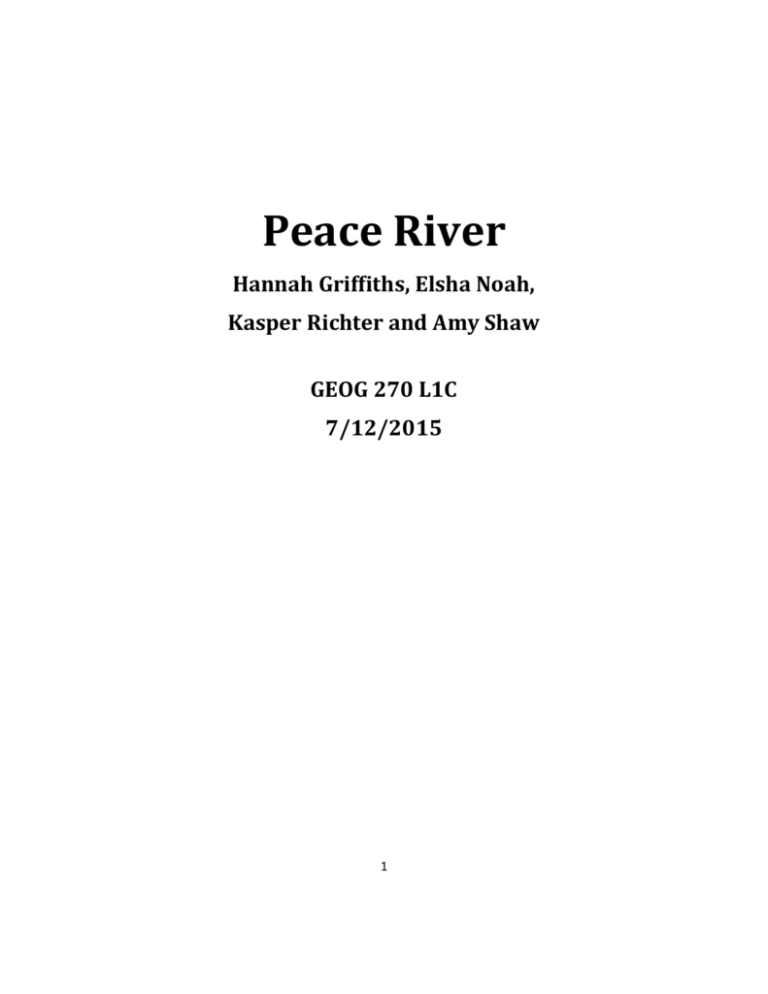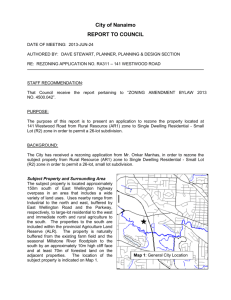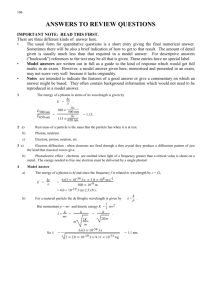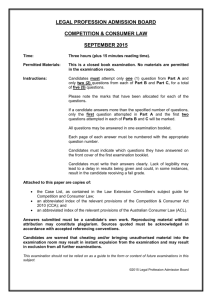Finalwriteup
advertisement

Peace River Hannah Griffiths, Elsha Noah, Kasper Richter and Amy Shaw GEOG 270 L1C 7/12/2015 1 Table of Contents Title Page Executive Summary 3 Introduction 3 Overview - Biogeographical 4 Overview - Social 6 Error and Uncertainty 10 Further Research 11 Appendix 12 2 Executive Summary This report provides a detailed account of the Peace River ALR, and the following information and analysis will be useful for those interested in researching British Columbia’s agricultural lands. In order to find out how much of the Peace River ALR is under threat, we looked at a number of different social and biogeographical issues. In doing this, we were able to map how much of the ALR is used for non-agricultural uses but has not been extracted from the estimate of arable farmland in the ALR. One of the main threats to the ALR is urban sprawl, shown via the density of roads shown on Map 5, along with a 2011 population of 20,193. Both roads and residents homes will decrease the area available for agricultural use. Furthermore, although oil extraction is not permitted in the ALR, Map 7 shows the high number of oil fields, and contrasts the high number that are unmanaged with oil management zones, an issue this report identifies as a key threat to the ALR. We also identified physical aspects of the ALR which limits its use for agriculture. Only 0.03% of the ALR is greater than 30º slope and 3.36% is rivers and lakes, meaning it can’t be used as arable land. However, we found that 61.66% of land in the ALR ranged between having severe limitations to having no capability for arable land, which demonstrates poor management of the land and soil quality in Peace River ALR. Introduction Agricultural Land Reserves (ALR) are of great importance to British Columbia. They are provincial land use zones of varying sizes created in 1973, whereby agriculture is recognised as the priority use for approximately 4.6% of the land base. They are very important for food security within British Columbia. However, it is becoming a great concern that only a significantly smaller percentage is suitable to growing a range of crops due to poor soil quality. Also, increasingly much of the land within these reserves is being lost to urban sprawl. It is therefore important to look at the land use in these zones to help ensure that they are sustainable for future generations and to guarantee that these figures do not decrease any further. The ALR this project is focusing on is that of Peace River. It is located east of the Rocky Mountains to the Alberta border. This site is of great importance to the ALR due to its large extent: in its entirety the Peace River boundaries encompass approximately 12million hectares (PRRD). This land is used for recreational use, hydroelectric power, oil and gas extraction as well as agriculture. 3 To study this area, data will need to be collected from a variety of sources, TRIM data will be used as a starting place to build upon. Data will then be collected from openstreetmap to look at infrastructure and BC-Data to look deeper into land use. Statistics Canada, along with Abacus and CHASS, will then further evaluate population characteristics and demographics. These sources combined will then allow for evaluation of the Peace River ALR, to see how effective the area is at supporting and maintaining agricultural reserves for the ever growing population of B.C. Overview 1287641.09 Hectares of the provincial ALR was located in our subpanel region. This represented approximately 10.74% of the entire Peace River census division. Biogeographical The table below shows the types of land cover and how much of each type. Land Cover Unclassified Water Barren Developed Shrubland Wetland Herb Grassland Coniferous Broadleaf Mixed Wood Annual Crops Perennial Crops and Pasture Total Land Cover Area Area (m2) 63 826 105.06 55 599 463.11 580 259 772.94 23 078 396.18 447 038 623.98 658 889 708.33 2 201 609 712.72 10 478 582.89 2 316 321 287.00 3 008 998 570.58 331 498 670.68 1 079 307 377.91 2 099 504 667.76 Area (Hectares) 6 382.61 5 559.95 58 025.98 2 307.84 44 703.86 65 888.97 220 160.97 1 047.86 231 632.13 300 899.86 33 149.87 107 930.74 209 950.47 Percentage of ALR 0.50% 0.43% 4.50% 0.18% 3.47% 5.11% 17.08% 0.08% 17.97% 23.35% 2.57% 8.37% 16.29% 12 876 410 939.15 1 287 641.09 99.90% We divided land cover up into 14 categories based upon the Harmonization Land Cover Classification Legend. These categories include: Water, Barren, Developed, Shrubland, Wetland, Herb, Grassland, Annual Crops, Perennial Crops and Pasture, Coniferous Forest, Broadleaf Forest, Mixed Wood Forest, and Unclassified. Broadleaf Forest takes up the greatest percentage of the ALR at 23.35%. Coniferous, Herb, and Perennial Crops and 4 Pasture are the most significant categories that follow Broadleaf, as they respectively compose 17.97%, 17.08%, and 16.29% of the total ALR area. The table below shows the amount of water in the ALR: Water Feature Lakes Rivers Total Water Area Area (m2) 73 694 858.64 363 145 370.56 436 840 229.20 Area (Hectares) 7 369.49 36 314.54 43 684.02 Percentage of ALR 0.57% 2.82% 3.39% When buffering the water features, we only included rivers and lakes that were located in the ALR. This area does not include the Peace River itself, as it is not considered part of the ALR. Overall, while these rivers and lakes are numerous they only account for 3.39% of the total ALR area. The next table are the soil agricultural capability class types. Class Limitations Area (m2) 1 2 3 4 5 6 7 O No Significant Limitations Moderate limitations Moderately severe Severe Very severe Perennial only No capacity for arable Organic soils Total Soil Area 42 883 711.29 1 100 268 217.98 3 767 560 884.63 4 448 126 336.54 3 072 547 681.31 151 272 173.07 276 078 277.85 95 407.53 12 858 832 690.20 Area (Hectares) 4 288.37 110 026.82 376 756.09 444 812.63 307 254.77 15 127.22 27 607.83 9.54 1 285 883.27 Percentage of ALR 0.33% 8.54% 29.23% 34.51% 23.84% 1.17% 2.14% 0.001% 99.77% The vast majority of the land in the peace River ALR falls in the middle classes, suggesting that there are moderately severe to very severe limitations to the agriculture capability of the Peace River ALR. Class 4 soils, or soils with moderately severe limitations, make up the bulk of the ALR area at 34.51%. Class 3 (Moderately severe limitations) and class 5 (Very severe limitations) come in at a close second and third respectively, Only 0.33% of the soil in total ALR is has no significant limitations to its capabilities. Some of the agricultural land was too steep for growth: Slope < 30º > 30º Area (m2) 12 872 788 862.49 3 619 318.63 Area (Hectares) 1 287 278.89 361.93 5 Percentage of ALR 99.87% 0.03% Total Slope Area 12 876 408 181.11 1 287 640.818 99.90% As seen in Table 4, only 0.03% of the area in the Peace River ALR has a slope greater than 30º. The overwhelming majority of the variation in slope that occurs in this valley is below 30º, and makes up 99.90% of the total ALR area. Flat areas are better for agriculture. The farmland of the Peace River Census Region accounts for 32% of BC’s total provincial farmland. 240,735 hectares are used for hay and field crop production. The Peace River Census Region makes up the significant majority of provincial agricultural production, an area which has grown by 49% in between 2006 and 2011. This area is primarily used for growing canola and oilseed, with 94% produced within. Other major grains grown in this region include wheat (87%), barley (60%), and mixed grains (41%). There has been a significant decline in the area dedicated to the production of berries (-71%), vegetables (45%) and Christmas trees (-40%) between 2006 and 2011. Social To calculate the total km’s of roads in the ARL subpanel shapefile was downloaded and two different sets of data were evaluated. The first data we looked at was Open Street Map. This described 13 different types of road ranging from: footway, path, primary, residential, road, secondary, service, tertiary , tertiary_link, track, trunk, trunk_link and roads that were unclassified. In total we found the total length of roads to equal 76.054088km. To compare with other sources we also looked at the TRIM data this had information on: decommissioned roads, gravel roads with one lane, gravel road with one lane u/c, gravel road with 2 lanes, overgrown roads, paved roads with 2 lanes, 3 lanes or 4 lanes, rough roads and winter roads. in this case the total length of roads was 1782.1159772535km It was evident that the TRIM data was the best to use for our ARL of the Peace River so it was the data used in further analysis. The next step was then to create a buffer on the roads of 10m each side. This gave us a total buffer area of 35207.149836037 ha. The total area of the Peace River ARL is 1288902.758955ha, therefore the total percentage of land surface that is roads is 2.73%. This was then mapped (Map 5). Further display could have been shown on the map via different road types, however do to the large scale of the ALR this would not be relevant or practical to display on the map. Next it was important to identify parks. However, there was very little data to be found on parks at any scale. For example, there were no national park data for our region. We found 6 ecological sites and conservation parks, but they covered a very small region of our ARL. Finally, in the TRIM data we found a small amount of area consists of picnic parks. Parks Area (hectares) Picnic Parks 5.9100517637 Ecological Reserve 201.133279 Provincial Park 3030.517395 Total 3237.56072576 There were found to be 7 golf courses within our study site; 6 of which were in very close proximity. The total area of these was found to be 45.79141295ha. Together the parks and golf courses were mapped (Map 6) to illustrate their spatial extent. It was then important to look at population size. We first looked at the entire census division data on Statistics Canada gave us a value of 60,082 in 2011. The next step to get a better estimate was to download CHASS data to find dissemination areas. This data was then clipped them to our ARL. We found there to be 4 dissemination areas: Peace River B, C, D and E. The next step was to then explore Statistics Canada. We looked at each dissemination area individually. Dissemination Area Population (2011) Peace River B 5552 Peace River C 6398 Peace River D 5479 Peace River E 2764 7 This gave a total population of 20193. This is a better estimation of the population as it is fitted more directly to our ARL of the Peace River To look at population demographics, again the first step of this process was to look at the entire census division. We did this with evaluation of Statistics Canada. We decided to focus our research first on age and number of people in households. We also looked at ethnicity using Abacus. Abacus Provided the following data on ethnicity on the census division scale: Ethnicity Population North American 6520 North American Aboriginal 8920 Other North American Originals 19200 Caribbean 175 Latin, central and South American Origins 140 European 44595 We then followed the age distribution for the ALR. We also zoomed in to focus on dissemination areas. 8 Finally, we looked at the size of house dwellings. Due to the total for the census dissemination areas living in a 2 person dwelling was 2875, in 3 was 1080, in 4 was 1045 and finally 5 plus was 760. Our research showed us that oil extraction was a large issue for our ARL. BC Parks states that “Gas reserves are being developed in the region, and there is a high potential for future gas discoveries throughout the valley corridor.” However under the permitted uses in the ARL, there is no mention about oil and gas extraction. It also doesn’t come under the permitted use in the Agricultural Land Reserve Use, Subdivision and Procedure Regulation (ACL, 2002). However, since 1976 the ALC has worked collaboratively with industry to develop a process of allowing the non-farm use of land in the ALR for oil and gas activities without the need of an application. This has occurred because this kind of activity is deemed as temporary and vital for economic development. However, they are a large risk to biodiversity and greatly impact land uses (ALC, 2013). Therefore we collected data from BCdata of oil and gas management areas and the location of oil and gas fields. TRIM data proved the location of oil and gas wells, as well as pipelines. This allowed us to compare the location of extraction to the areas managed. We found that a significant amount of extraction was occurring in areas of no management. Summary Out of the 1288902.759 Hectares in the Peace River ALR, only 539639.47 (or 41.87%) is available for agricultural purposes. I feel that these estimates are fairly accurate for the ALR of the peace River region. The research that we have undertaken suggests that there has been a great deal of changes in the land use of the Peace river region in the last 10 years ago, and so the official estimates, which are based on 1978 data, are likely to have some inaccuracies. There is even a discrepancy between the total ALR land listed in the ALC and the one of the Peace River Shapefile. Error and Uncertainty Error and uncertainty are issues that anyone using GIS must be aware of and be able to mitigate in order to create a high quality map, and therefore produce a reliable analysis. 9 We will outline areas of our project which encountered issues of uncertainty and potential error, and how we worked around these issues to ensure our analysis was accurate and reliable. When collecting data for the social section of the project, we found BC Data to be a great source of information. However, when searching for data on parks in the Peace River ALR, when we downloaded the data and clipped it to our ALR layer, there were no parks that were in our area. We thought this seemed incorrect, so we engaged in further research by using Google Maps to view the Peace River region and see if there were any parks that the BC Data had not included. Along with this, we used information from BC tourism websites to confirm that there are parks in this area. This shows that we must be critical of the data we download, as it can contain missing information which will therefore affect further analysis. Although GIS consultants are aware that it is impossible for data collection to be completely accurate and capture information on everything in the area of interest, we must consider if, due to the chance of missing data, can maps and subsequent analysis be trusted? Metadata is very useful when collecting data to display in a GIS map, as it reassures the consultant that the data is reliable by listing who collected the data, when it was collected and who has edited it since. Much of the data that we collected did not come with metadata, which caused some concern over its reliability. When collecting data for roads in our ALR, we first consulted open source data. When clipped to our ALR, the total length of roads was found to be 76km. To ensure accuracy, we compared this data to TRIM data, where we found the total length of roads in the ALR to be 1782 km. This shows that there is a lot of information missing from the open source data, resulting in an incorrect an analysis. We therefore used TRIM data for the rest of our analysis as it included more data for the Peace River ALR. It was noted that a small portion of our shapefile fell outside the areas we were using data from, which resulted in an average of 0.01-0.24% difference in terms of error. Due to how small this value is, we do not anticipate it affected our analysis. Finally, we were confined to using non-restricted data which is open to the public. This was particularly frustrating when we came across data sources which would aid our analysis, particularly the case for oil data, but was not open for download. Not being able to include this data would severely affect our analysis and solution to the problem. To mitigate this, we downloaded multiple public datasets which, when combined with each other and TRIM data, allowed us to make a similar analysis than if we were using the restricted file. Using many shapefiles instead of one is more time consuming, but there is also the chance of overlap of data. However, using more than one source can increase reliability of the data. 10 Further Research In order to get greater accuracy in our findings, there are several things to keep in mind. Firstly, finding data on public parks and ecological areas was difficult, so if possible it would be ideal to do a follow-up survey on the amount of parkland in the ALR. Oil and gas extraction within the ALR is prohibited according to the list of ALR exemptions. However, we discovered that there is still exploration that occurs, and that the oil and gas management areas do not actually cover our entire ALR region. There are some areas that are not under management and are vulnerable to unscrupulous extraction. As well, there is a large financial incentive to extract the large quantities of oil and gas in this region, making it even more important to safeguard the agricultural land. The management zones should be extended, and should be actually managed, to avoid degradation and contamination of land in the ALR. This should be further monitored by the government. Another huge threat to the ALR is the proposed hydroelectric dam known as Site C. Site C would be the third dam on the Peace River. The Site C dam would cause flooding along 83 km of the Peace River, submerging 3433 hectares of Class 1-3 agricultural land. It would also increase the risk of erosion, landslides, and other mass wasting along the new banks of the reservoir. There is significant opposition to the Site C project proposal, including several local First Nations groups who have threatened legal action against the provincial government. They claim that the proposal by BC Hydro only takes into account the land that would be submerged, and does not take into account the impact to the land that would become new riparian buffer, or that would now be vulnerable to soil erosion, landslides or seasonal flooding. As such, the impacted land is a much greater area than originally listed. Finally, as the Peace River is quite far north, we should also consider the impacts of climate change. Predictions have indicated that the North is warming much quicker than average, and this can affect many things, including average rainfall, growing season, temperature, and even the severity of plant pathogens. Climate change needs to be carefully studied so that we can mitigate the damage and adapt to our changing environment. 11 Appendix References References: BC Parks. Peace River. Retrieved from: http://www.env.gov.bc.ca/bcparks/heritage_rivers_program/bc_rivers/peace_river.html ALC (2002) Agricultural Land Reserve Use, Subdivision and Procedure Regulation. Retrieved from: http://www.alc.gov.bc.ca/assets/alc/assets/legislation-andregulation/the-act-and-regulation/alr_reg_171-2002.pdf ALC (2013) Provincial Agricultural Land Commission. Retrieved from: http://www.alc.gov.bc.ca/assets/alc/assets/about-the-alc/working-with-other-ministriesand-agencies/history_of_oil_and_gas_activities_in_the_alr_november_2013.pdf Peace River Regional District. Retrived from: http://prrd.bc.ca/ Statistics Canada (2009) Census Profile. Retrived from: http://www12.statcan.gc.ca/census-recensement/2011/dppd/prof/details/page.cfm?Lang=E&Geo1=CD&Code1=5955&Geo2=PR&Code2=35&Data=C ount&SearchText=&SearchType=Begins&SearchPR=01&B1=All&Custom=&TABID=1 ` List of Data Sources TRIM Data BC Data CHASS Abacus Statistics Canada 12 Biogeographical: 13 Social: 14 Summary: 15 Map 1 16 Map 2 17 Map 3 18 Map 4 19 Map 5 20 Map 6 21 Map 7 22 Map 8 23 Review of Team Member Contributions Our team divided up the tasks we were required to complete, with Amy and Hannah completing the social threats to the ALR and Kasper and Elsha researching the biogeographical aspects of Peace River, and each of these pairings wrote their respective part of the body of the report. Kasper completed the maps in the overview section showing the total amount of ALR in the Peace River census division, along with final summary Map 8. When collating the final report, Hannah introduced the report, Amy followed by summarizing our findings, and finally Elsha reported on further research required. Overall, each team member contributed evenly and we worked as a team effectively, helping each other when we ran into problems when collecting data and producing our maps. 24







